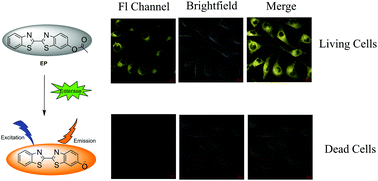A sensitive and rapid “off–on” fluorescent probe for the detection of esterase and its application in evaluating cell status and discrimination of living cells and dead cells†
Abstract
The discrimination of living and dead cells shows great importance in the development of biology, pathology, medicine, and pharmacology research. Herein, we synthesized a simple benzothiazole-based probe, EP, which was characterized via1H NMR (hydrogen nuclear magnetic resonance) spectroscopy, 13C NMR (carbon nuclear magnetic resonance) spectroscopy and HRMS (high-resolution mass spectroscopy). The fluorescence changes in response to esterase were characterized via fluorescence spectroscopy. EP exhibited a 70-fold fluorescence enhancement in the presence of esterase and possessed a very low limit of detection (4.73 × 10−5 U mL−1). EP also showed high selectivity to esterase compared to other biological species. Bright fluorescence appeared in living cells, which was activated by esterase when incubated with EP. In paraformaldehyde or H2O2 pretreated cells, the fluorescence became very weak since esterase became inactive in these cells. In summary, the EP probe can monitor esterase activity both in vitro and in living cells and can be used to evaluate the health status of cells and discriminate living and dead cells effectively.



 Please wait while we load your content...
Please wait while we load your content...